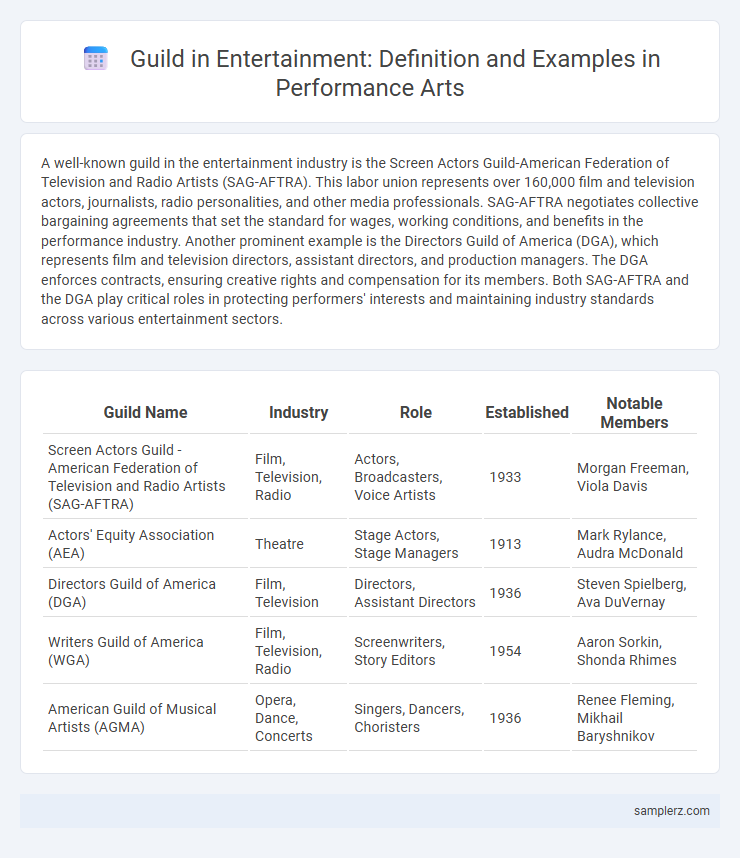A well-known guild in the entertainment industry is the Screen Actors Guild-American Federation of Television and Radio Artists (SAG-AFTRA). This labor union represents over 160,000 film and television actors, journalists, radio personalities, and other media professionals. SAG-AFTRA negotiates collective bargaining agreements that set the standard for wages, working conditions, and benefits in the performance industry. Another prominent example is the Directors Guild of America (DGA), which represents film and television directors, assistant directors, and production managers. The DGA enforces contracts, ensuring creative rights and compensation for its members. Both SAG-AFTRA and the DGA play critical roles in protecting performers' interests and maintaining industry standards across various entertainment sectors.
Table of Comparison
| Guild Name | Industry | Role | Established | Notable Members |
|---|---|---|---|---|
| Screen Actors Guild - American Federation of Television and Radio Artists (SAG-AFTRA) | Film, Television, Radio | Actors, Broadcasters, Voice Artists | 1933 | Morgan Freeman, Viola Davis |
| Actors' Equity Association (AEA) | Theatre | Stage Actors, Stage Managers | 1913 | Mark Rylance, Audra McDonald |
| Directors Guild of America (DGA) | Film, Television | Directors, Assistant Directors | 1936 | Steven Spielberg, Ava DuVernay |
| Writers Guild of America (WGA) | Film, Television, Radio | Screenwriters, Story Editors | 1954 | Aaron Sorkin, Shonda Rhimes |
| American Guild of Musical Artists (AGMA) | Opera, Dance, Concerts | Singers, Dancers, Choristers | 1936 | Renee Fleming, Mikhail Baryshnikov |
Defining a Performance Guild: Core Concepts
A performance guild is a structured community of artists and technicians collaborating to enhance theatrical productions, focusing on skill development, resource sharing, and maintaining quality standards. Core concepts include collective responsibility for artistic excellence, fostering mentorship opportunities, and ensuring fair labor practices within the entertainment industry. These guilds play a crucial role in shaping performance consistency and protecting the rights of their members.
The History of Guilds in Performing Arts
Guilds in the performing arts, such as the Actors' Equity Association founded in 1913, have historically protected the rights and working conditions of performers worldwide. These organizations established standards for contracts, wages, and working hours, fostering professional development and collective bargaining power. The evolution of such guilds reflects the broader history of labor movements within theater, film, and television industries.
Modern Examples of Performance Guilds
Modern performance guilds such as the Screen Actors Guild-American Federation of Television and Radio Artists (SAG-AFTRA) exemplify contemporary organizations that advocate for actors, broadcasters, and recording artists, ensuring fair wages and working conditions. The Actors' Equity Association (AEA) represents theater actors and stage managers, enforcing contracts and providing health benefits specific to live performance professionals. These guilds leverage collective bargaining to protect creative talents in film, television, radio, and stage, adapting to evolving industry standards and technological advancements.
Functions of Guilds in Theatre Productions
The Actors' Equity Association serves as a key guild in theatre, ensuring fair wages, safe working conditions, and standardized contracts for performers. It negotiates collective bargaining agreements that govern rehearsal hours, performance schedules, and benefits, thereby protecting actors' rights. Guilds also provide professional development opportunities and arbitration services to resolve disputes during productions.
Role of Guilds in Dance Performances
Dance guilds play a crucial role in organizing and preserving traditional choreography, ensuring authentic performances that reflect cultural heritage. They provide structured training and mentorship, fostering skill development and artistic innovation among dancers. By coordinating performances and managing resources, guilds enhance community engagement and promote the sustainability of dance as an art form.
Case Study: Musicians’ Guild in Live Shows
The Musicians' Guild exemplifies a successful guild in live entertainment by advocating for fair wages, standardized contracts, and improved working conditions for performers. Their collaboration with event organizers ensures consistent sound quality and professional support during live shows. This case study highlights the guild's role in elevating performance standards and protecting artists' rights in the competitive live music industry.
Guild Influence on Set and Costume Design
The International Alliance of Theatrical Stage Employees (IATSE) significantly influences set and costume design by establishing industry standards and safeguarding artists' creative rights. Through collective bargaining agreements, the guild ensures fair wages and working conditions for designers and technicians, fostering high-quality, innovative production aesthetics. This structured support empowers designers to push artistic boundaries while maintaining professional consistency across entertainment projects.
Performance Guilds and Talent Development
Performance guilds serve as essential platforms for nurturing artistic talent and fostering collaborative skill development among actors, dancers, and musicians. These guilds provide rigorous training programs, mentorship opportunities, and industry connections that enhance performers' professional growth and versatility. By facilitating workshops and live showcases, performance guilds contribute significantly to elevating the overall quality and innovation in the entertainment industry.
Guilds in Film and Television Production
Guilds in film and television production, such as the Screen Actors Guild-American Federation of Television and Radio Artists (SAG-AFTRA) and the Directors Guild of America (DGA), play a crucial role in protecting the rights and wages of performers and crew members. These organizations establish industry standards for working conditions, negotiate collective bargaining agreements, and provide legal support to thousands of members across the entertainment sector. Their influence ensures fair treatment and professional standards in the highly competitive environment of film and television production.
The Future of Performance Guilds in Entertainment
Performance guilds such as the International Alliance of Theatrical Stage Employees (IATSE) play a crucial role in advocating for fair wages, safety standards, and creative rights within the entertainment industry. Emerging technologies like virtual reality and AI-driven productions are reshaping guild responsibilities, necessitating updated contracts and training programs tailored to digital performance environments. These guilds are pivotal in ensuring that artists and technicians receive equitable treatment while adapting to rapid technological advancements in entertainment performance.

example of guild in performance Infographic
 samplerz.com
samplerz.com